|
|
Rock Sand

|
|
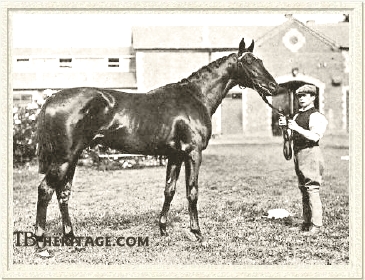 |
|
|
Although he was a top juvenile racehorse and English Triple Crown winner, Rock Sand is not generally considered among history's elite runners. His losses, by three lengths to Ard Patrick and the great race mare Sceptre in the Eclipse Stakes, to Sceptre by four lengths in the Jockey Club Stakes, and to Zinfandel and Sceptre in the Coronation Cup, being conceded weight in the first two, has always cast a cloud on his racing quality. He left an excellent racing son in Tracery, whose grandson, Congreve would become one of the most influential stallions ever in South America, and through Tracery his sire line also continued in England to Papyrus, and in Australasia through Pantheon and Archery. In the U.S., his good staying son Friar Rock got the fast, long-running handicapper Pilate, sire of the game, weight-carrying and speedy Eight Thirty. But it was through his daughters that Rock Sand has the most significant impact on the breed.
|
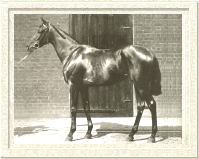
His dam, Roquebrune
| |
He was the only consequential runner sired by Derby winner Sainfoin, who is more noted for being the dam's sire of both Phalaris and Hurry On. Rock Sand's dam, Roquebrune, was a half-sister to dual-classic winner Seabreeze, and daughter of the One Thousand Guineas winner St. Marguerite and the undefeated St. Simon. Roquebrune ran three times in three seasons: she won Ascot's New Stakes as a juvenile, and Doncaster's Zetland Stakes at age three. An exceptionally high-strung filly, she was called a "trainer's nightmare." Rock Sand was likewise known as a temperamental horse, although it did not interfere with his racing.
|
Rock Sand was bred by Sir James Miller at his Hamilton Stud in Newmarket. Miller had purchased Roquebrune as a yearling for 4,100 guineas from the dispersal sale of the Duchess of Montrose's stud, and Sainfoin before he won the Derby. Rock Sand was Roquebrune's first foal, born when she was age seven. He was a small colt, and a poor mover until he stretched out on the turf, later maturing to 15.3 hands, closer in type to his maternal grandsire St. Simon, than to his sire. Even though his inclusion in the top rank of racehorses was questioned, and he never met his generational rival, Zinfandel, in the classics, he did triumph in sixteen of his twenty starts against top company, almost all of them easy wins.
Rock Sand on the Turf
Rock Sand was a very good juvenile runner, winning six of his seven starts, his only loss the Middle Park Plate. His wins included Newmarket's Bedford Stakes, Epsom's Woodcote Stakes, Ascot's Coventry Stakes, Newmarket's Chesterfield Stakes, and Doncaster's Champagne Stakes, all reeled off in succession and all but the Coventry Stakes -- where he barely beat the good filly Baroness La Fleche (out of the great La Fleche) by a head -- won easily. Next was his inexplicable third to two good colts, Flotsam and Greatorex, in the Middle Park Plate. His last race and win of the season was Newmarket's Dewhurst Stakes.
After his brilliant juvenile season, he entered his second highly favored for the Derby, and he went on to win not only that, but the Two Thousand Guineas and the St. Leger, making him one of England's rare English Triple Crown winners. His first race was Newmarket's Bennington Stakes, which he won easily. He went into the Two Thousand Guineas as favorite, and easily won it by 1 -1/2 lengths, ahead of Flotsam and Rabelais two lengths further back. Odds-on favorite for the Derby, he won by two lengths, over the French horse Vincius, with Flotsam four lengths behind in third. Next up was Ascot's St. James's Palace Stakes (8 furlongs), again an easy win.
His next race was Sandown Park's Eclipse Stakes (10 furlongs), which excited great public interest because he was to meet the four year olds Ard Patrick, who had won the previous year's Derby, and the great mare Sceptre, winner of the other four classics the year before. In this race Rock Sand was left in the dust, three furlongs from home; Ard Patrick went on to beat Sceptre by a neck, with Rock Sand a poor third. The results of this race opened a crack in Rock Sand's claim to be among the greats of the era.
His next race, the St. Leger, which he won easily, at least left him the acclaim as the best of his generation. In the fall he went to Newmarket for the Jockey Club Stakes over 14 furlongs; Ard Patrick had been sold to Germany, but he would meet Sceptre again (she conceding six pounds to Rock Sand). The great mare ran perhaps her finest race, beating Rock Sand by four lengths. This was Rock Sand's final race of the season.
The next year Rock Sand burnished his good reputation, and went a ways towards limiting the damage done to him in the Eclipse and Jockey Club Stakes. But serious questions regarding his true capabilities were still raised because in his first race, Epsom's 12 furlong Coronation Cup, he met for the first and only time his generational rival, the Persimmon colt Zinfandel, whose nominations to the classics had been voided due to the death of his nominator, Colonel Harry McCalmont. In this race Zinfandel triumphed, with Sceptre running second, and Rock Sand third. After that Rock Sand won four races easily, carrying high weights: the Hardwicke Stakes (12 furlongs), in which he finally defeated Sceptre, by five lengths (she had run in the 2-1/2 mile Ascot Gold Cup the day before); the Princess of Wales's Stakes (12 furlongs); the Lingfield Park Plate (1-1/4 miles); the First Foal Stakes, and the Jockey Club Stakes (14 furlongs).
Although he remained in training with George Blackwell through the winter of 1904-5, with the Ascot Gold Cup as the target, persistent tendon trouble did not clear up, and he was retired to his owner's stud in April of 1905, where he was put to a very few mares.
Rock Sand in the Stud
As a stallion, he was never better than eleventh on the leading sires list in the U.S. (1916), and was only in the top twenty twice. These standings are somewhat misleading, since he had many good winning offspring -- including his best son, Tracery, and the good French runner Vulcain -- that his American purchaser, August Belmont, either shipped overseas to run, or were conceived in the U.S. and shipped in-utero to Europe where they won lucrative races. In fact, Rock Sand was fourth on the leading sires list in England in both 1912 and 1913, though he stood at stud in the U.S. He was twelfth on the list in England in 1915, due to his French-conceived foals.
In the U.S. he fared better as a sire of juveniles, hitting number five on the list in 1915. As a sire of broodmares (including a number of daughters that returned to the U.S. for their stud careers) his record was considerably better in the U.S., due in part to the cross of his daughters with the stallion Fair Play. He was third on the broodmare sire list in 1924 (behind that great broodmare sire Star Shoot and Broomstick), fourth in 1925, eighth in 1926, and seventh in 1929. His daughters produced a number of divisional champions and leading sires in two countries. His sons Trap Rock and Friar Rock also regularly made the top twenty in the leading broodmare sires lists throughout the 1920s. It should be noted that a number of top winners of steeplechases in Europe and the U.S. traced within two generations to Rock Sand. One of his grandsons, Cottage, was the sire of three Grand National Steeplechase winners, and was dam's sire of Cottage Son (1944, by Young Lover, who was out of a Rock Sand grandaughter), the most influential stallion in the Holstein sport horse breed.
After his truncated 1905 season, Rock Sand had a full book, but Sir James died in 1906, and American August Belmont, Jr., purchased Rock Sand for £25,000 from the Miller estate after the season's end. Accompanying Rock Sand on his trip to the U.S. and Belmont's Nursery Stud at Lexington, Kentucky, was Topiary, an Orme daughter in foal to Melton, and with a Bushey Park colt at foot, who had won one small race at Lanark for her owner, Lord Hamilton. Her merit, at the time, was her pedigree; she had been bred at the famous Yorkshire Sledmere Stud and was out of excellent and versatile race mare Plaisanterie (winner of the "fall double"-- the 18 furlong Cesarewitch Stakes and the nine furlong Cambridgeshire), and so a half-sister to Cesarewitch winner Childwick.
Rock Sand was put to very few mares in England 1905, and only three foals were registered in 1906. One of these died; another, COASTWISE, went on to win the Liverpool Cup and four other races. Rock Sand's 1907 crop consisted of nineteen foals, nine of which were winners. These included ROCHESTER, from the good-producing Sir Visto mare, Caparison; he won the Newbury Spring Cup (1 mile-2 furlong-170 yards). Rochester was later the sire of some good producers; his daughter Sargo (1926) won the Liverpool Autumn Foal Stakes and later produced winners; Missinaibi won the Redcar Foal Stakes and was sold to the U.S., where she produced five winners, including Sun Mission and Dark Mission; Lady Alan Breck was the dam of Prix Royal Oak winner Laeken (1929). Another Rochester daughter, Tryst, produced Young Lover (by Son-in-Law), a winner of the Gimcrack and Newmarket Stakes, and of the Newmarket St. Leger and the Scottish Derby; he made his mark in the world of show jumping by getting Cottage Son, a good sire of hunters and eventers in England before his export to Germany where his sons became influential stallions in Holstein and Dutch warmblood pedigrees. Another Rochester son, Daybreak (1916) was also a jumper: he won the grueling Maryland Hunt Cup. Rock Sand's other English-bred winners from his 1907 crop included ROCK LANE (won five races) and HALCYON (won six races).
In the U.S., Rock Sand joined Belmont's great crack racehorse and stallion Hastings; Lawrence Realization, Metropolitan Handicap and Brighton Cup winner Ethelbert (owned by Perry Belmont); Toboggan Handicap and Withers Stakes winner Octagon (sire of Two Thousand Guineas winner Norman III for Belmont); and Suburban Handicap winner and weight-carrier Henry of Navarre on the roster at the Nursery Stud. He spent six seasons there, until the U.S. racing blackout of 1911 and 1912 pushed Belmont to sell Rock Sand for £25,000 to a syndicate that included New York Jockey Club steward and Saratoga Association president Francis Hitchcock, who, along with other wealthy Americans, were sending their stock overseas as a consequence of the anti-betting legislation in New York. He was sent to France, where he made two seasons before dying, purportedly of heart disease on July 20, 1914. It was reported he would gorge himself on his straw bedding, and had to be shifted to sawdust to prevent him from overeating, likely a nervous habit resulting from his finely-strung temperament, the same temperament that required his stall to be padded so he would not injure himself by kicking the walls.
In 1910, Hastings' son, Fair Play, joined the stallion line-up at Nursery Stud. Rock Sand's Nursery Stud daughters -- few of which Belmont allowed to race heavily or for long -- would prove to be a good cross with Fair Play, providing the American turf with some wonderful runners, the chief of which was Rock Sand's grandson, Man o' War.
Rock Sand's first U.S. crop were foals of 1908. A number of them were out of daughters of Rayon d'Or, the French-bred winner of the Doncaster St. Leger, that had been imported into the U.S. by William Scott. Standing at his Algeria Stud in Pennsylvania, Rayon d'Or was among the top five leading sires several times in the 1890s, and was at the top in 1889. Belmont purchased this stallion and some of his daughters at Scott's dispersal sale in 1892. One of these Rayon d'Or grandsons was FLINT ROCK, out of Fizgig, a good juvenile who broke down at age three after winning the Dominion Handicap; he was shipped off to France, where he stood at Belmont's Haras de Villers alongside Ethelbert, who had also been sent there. He was a failure at stud. Another member of this group was FOOTPRINTS, a son of Fetish, by Rayon d'Or. He was an excellent juvenile, winner of the Tremont and Double Event Stakes, and second in the Grand Union Hotel and National Stallion Stakes, winning seven of his fifteen starts.
|
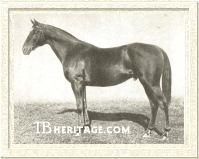
Trap Rock
| |
The chestnut TRAP ROCK was another foal of 1908; he was out of Topiary, the mare that had been imported with Rock Sand. He won the Hudson and Manhassett Stakes and three other races, and was second in the Great American Stakes. Very similar in appearance to his more famous brother, TRACERY, with the exception of his coat color, he was a successful sire of winners of over $385,000, and was several times in the top twenty of leading broodmare sires in the 1920s. |
Trap Rock's best was Lucullite (1915, from Lucky Lass, by Ormondale). He was a top juvenile, winning the Juvenile and Youthful Stakes among others, then missed his three-year-old season due to splintered bone from a kick during the running of the Hopeful Stakes. At age four he was the top handicap horse under the guidance of trainer Sam Hildreth. Deertrap, winner of the U.S. Hotel Stakes, the good juvenile Rock Man, and Lord Baltimore (12 wins, including the Flash and Whirl Stakes) were other stakes winners by Trap Rock. Trap Rock's daughter, Rock Emerald, was the dam of the champion steeplechaser Blockade, and another daughter, Rosequartz, was dam of three-time winner of the Maryland Hunt Cup, Winton.
Another member of Rock Sand's 1908 crop was the dark brown filly MADCAP, out of the good winning Rayon d'Or daughter Lady Madge. She produced two stakes winners for Belmont: Mad Hatter and Mad Play, both by Fair Play. Mad Hatter (1916) won the Latonia Championship Stakes at age three, the Jockey Club Gold Cup at ages ages three and four, and at age eight the Suburban Handicap. He got 23 stakes winners from 177 foals, including the durable gelding Cresta Run (171 starts), and the champion filly Snowflake. Mad Play (1921), sold to the Rancocas Stable as a yearling, won the Belmont Stakes, the Saratoga Cup and the Brooklyn Handicap; he proved to be sterile and got no offspring.
Another 1908 daughter was SANDWICH (from Hanover daughter, Tea's Over), who was sent to England to run, winning three races worth £1,412, including the Criterion Stakes at Newmarket. Her sister, TOGGERY (1909) won five races in England and was later the dam of Cri de Coeur, third dam of John's Joy and The Doge, and of Mlle. Dazie (1917, by Fair Play), winner of 14 races and dam of the fast juvenile and successful sire Jamestown. TEA BISCUIT (1912) was the third sister; she was born in England and ran there without success; as a broodmare there she produced Conversazione, who was sold to South Africa, where she won four races, and Reading, a 1918 filly by Sir Martin (who stood at stud in England, winner of three flat races, six hurdle races and three steeplechases. TEA BISCUIT was shipped back to the U.S., where she bred five winners, including Hard Tack, winner of the Saranac Handicap and two other races, best known as the sire of the immortal Seabiscuit. Irish Derby winner Ragusa, Kentucky Derby winner Hoop Jr., and CCA Oaks winner Grecian Queen are some other horses descending in tail-female from Toggery and Tea Biscuit. The fourth sibling in this Tea's Over - Rock Sand cross was the modest runner TEA CADDY (1913), who got some stakes winners, including the sturdy filly Teak (15 wins from 59 starts), and Maryland Hunt Cup winner Brose Hover.
DRAGNET was another 1908 Rock Sand daughter; she was out of Donna Mia, by Belmont Senior's stallion The Ill-Used. Dragnet was another good producer, dam of good winners Deckmate (1914) and Drastic (1915), both by Hastings, and of Lamp Black, by Black Toney.
Rock Sand's 1909 crop included the great runner Tracery, who continued the sire line, and some daughters that became top producers.
|
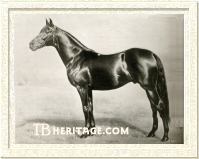
Tracery
| |
TRACERY (1909) was Rock Sand's best runner and best sire son. He was out of Topiary, and similar in appearance to his year-older brother, TRAP ROCK, but brown in color. He was an elegant animal, and game on the turf, but was plagued by spavins early in his career. Because of the racing blackout, Belmont sent him to England to race. He was placed in the hands of Leopold de Rothschild's trainer, John Watson, at Newmarket, but went unraced at age two due to spavins and/or other problems. His very first race as a three-year-old was the Epsom Derby, for which he was not prepared, and he ran third to Tagalie and Jaeger, beaten by four lengths. |
He was not defeated again that season, winning the St. James's Palace Stakes at Ascot over a mile, the Sussex Stakes at Goodwood, and the St. Leger (14-1/2 furlongs), which he won in a canter. At age four he won the Burwell Plate (12 furlongs), a prep race for him for the Ascot Gold Cup. In the Gold Cup he was leading when a crazy man ran into his path, and Tracery fell. He then won the Eclipse Stakes over ten furlongs, ran second to Cantilever (receiving 27 pounds from Tracery) in the Jockey Club Stakes, and finished his career by winning Newmarket's ten furlong Champion Stakes. He had shown he was an incredibly game and versatile runner.
Tracery remained in Belmont's ownership (he had refused an offer of £40,000), but stayed in England, serving mares from Rothschild's stud at Southcourt, Leighton Buzzard for a fee of £400. His fee dropped in the war years of 1917 and 1918. He had no winners in his first crop; his second crop included The Panther (winner of the Two Thousand Guineas), and in the ensuing seasons in England he got the stakes winners Abbots Trace, Flamboyant, Obliterate (sire of Oaks winner Quashed), Monarch, Waygood, Nera da Bicci (speedy Italian filly, influential producer in Germany), Teresina (winner of Goodwood Cup, dam of Alibhai and Irish Oaks winner Theresina), Tamar and Derby winner Papyrus. In 1920 S.J. Unzue purchased him for £53,000, and he was sent to Argentina, where among others, he sired El Cacique. Tracery's sons, The Panther, and Copyright (Ascot Gold Vase, sire of Congreve) followed him to Argentina, where they were enormously influential at stud.
Tracery also had an influence of Australasian bloodstock through the good stallions Pantheon (a staying winner in England and Australia), Archery, and Psychology: the great New Zealand staying mare Cuddle, and the big, beautiful chestnut Australian stayer Peter Pan (a son of Pantheon), were descended from him.
He got some top stayers, including Doncaster Cup winner Flamboyant and Teresina, but most of his youngsters won between nine and ten furlongs. His son, Monarch (1918), got two good jumpers in Gran Premio Merano winner Roi de Treflet (1928) and Grand Steeplechase de Paris winner Potentate (1929). Another son, Cottage (1918), was a noted sire of steeplechasers, whose sons included three Grand National Steeplechase winners and two Cheltenham Gold Cup winners. Cottage was also dam's sire of the aforementioned Cottage Son, in-bred to Rock Sand.
Tracery was second, third, fifth and seventh in the leading sires list in England in the early 1920s, and a leading sire of juveniles in 1920. After three years in Argentina he was purchased back to England by a syndicate of leading breeders that included the Aga Khan, Marcel Boussac, Lord Wavertree, and Major D. McCalmont. He died a year later, in 1924, at Cobham Stud, from complications following colic.
|
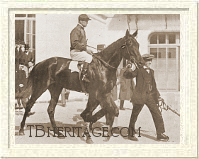
Qu'elle Est Belle
| |
In 1909 several American mares bred to Rock Sand were shipped to France, and dropped their foals there. One of these was the St. Florian daughter, Queen's Bower. In 1909 at Haras de Villiers, she dropped QU'ELLE EST BELLE. She won over 120,000 francs, her triumphs including the Prix La Rochette and the Prix de Diane (French Oaks). Sent to the U.S., Qu'elle est Belle dropped Quelle Chance (1917, by Ethelbert), the dam of the great Fair Play sons Chance Play (1923, Jockey Club Gold Cup, Saratoga Cup) and Chance Shot (1924, Belmont Stakes, Saratoga Special, Withers Stakes). Both colts became good sires, with Chance Play leading sire twice in the U.S., and Chance Shot sire of champion filly Fairy Chant, among other good stakes winners. |
Hautesse, by Archiduc, was another trans-Atlantic traveller. Bred in England and imported to the U.S., she was sent to France in foal to Rock Sand, dropping her filly HOUR GLASS II in 1909. Bred to Negofol in France, Hour Glass II was sent to England, where she dropped her son, Hourless, at Leopold de Rothschild's Southcourt Stud in 1914. With World War I looming, Hourless was sent to the U.S. in 1915. Hourless was champion juvenile colt and champion three-year-old colt in the U.S., his wins at three included the Withers, the Belmont by ten lengths, and the Champion Stakes at Belmont Park, setting a new course record over 1-1/4 miles. He got some winners and producers, including the gelded Mike Hall, winner of $213,420, and the in-bred Missionary (1919, out of MISSION, by Rock Sand), a good juvenile runner. HOUR GLASS II was bred to Prince Palatine while in England, and in 1917 dropped BLUE GLASS, who was brought to the U.S.; unraced, she produced eight winners for Belmont and then Joseph Widener, including Unbreakable (1935, by Sickle), a successful stakes winner in England and Belmont Stakes winner Hurry Off.
Another Belmont mare that went to France in foal to Rock Sand was Fidena, by Rayon d'Or. She dropped the chestnut filly FIAMETTA in 1909, a winner of provincial races at ages two, three and four, including the Prix des Etangs, the Prix des Saules, and the Prix Borealis. In France Fiametta bred some winners, and later was sent to the U.S.
Rock Sand's daughter SUN QUEEN (1909), out of another Rayon d'Or daughter, Souriante, was unraced; she remained in the U.S. She produced Coventry (1922, by Negofol), whose only win in five starts was the Preakness Stakes.
Another 1909 Rock Sand daughter bred by Belmont was FELICITY, from Fides, by The Ill-Used. She stayed in the U.S., and produced some winners, including Sporting Blood (1918, winner of the Travers Stakes) and Festival (1923), both by Fair Play, and in 1924 dropped the liver chestnut Arc Light, by imported Archaic. Joseph Widener purchased both Felicity and Arc Light after Belmont's death in December of 1924. Useless on the flat, Arc Light was put in the hands of the top steeplechase trainer Howard Lewis, who also developed Bushranger, Duettiste, Fairmount, and Lizard, all for Widener. Arc Light won the Manly Memorial Steeplechase in record time at age four, and at five won four races, including the American Grand National, the Temple Gwathmey, and the Manley Memorial again. In 1930 he won the American Grand National, but was disqualified on a judged foul, although his time record for that race was allowed to stand; that year he also won the Governor Ogle Steeplechase, carrying 154 pounds, and the Temple Gwathmey in New York for a second time. In 1932 he won the Charles L. Appleton Memorial Steeplechase, and in 1934, age ten, won the Meadow Brook Steeplechase and was second in the Brook and the Grand National. After six years of racing and 36 races, with 13 wins, 8 seconds and six thirds, he was pensioned to Widener's Lynnewood Hall estate at Elkins Park, Pennsylvania, where he died early from complications due to an infected foot.
Another 1909 Rock Sand offspring that could jump was MISSION (from the Diudonne mare Misgivings), who won the American Grand National in 1915. She later produced Missionary (1919, by Hourless, and so in-bred to Rock Sand), bred by Belmont; for E.F. Simms Missionary won the Remsen Stakes and the Manor Handicap as a juvenile, and the Shenandoah Handicap at age three. Mission also bred good runners in the gelded Grenadier (1918, by Fair Play), and the modest winner Messenger (1920, by Fair Play).
Rock Sand's third crop (1910) included Rock View, Vulcain, and Mahubah, Man o' War's dam. |
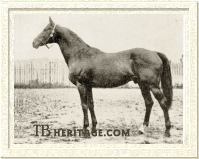
Vulcain
| |
VULCAIN (1910) was born in France from Lady of the Vale. She was by Rayon d'Or and out of Lady Violet, a mare Belmont purchased as a yearling who had been a terrific weight-carrier and excellent juvenile runner and later the dam of four stakes winners. Lady of the Vale was one of the in-foal mares that crossed the Atlantic to Haras de Villers. Vulcain was not an impressive juvenile, but at age three was one of the best of his generation in France, winning the Prix Miss Gladiator (2100 meters), the Prix Noailles (2200 meters), and the Prix Reiset (3000 meters), and running third in the Prix Juigne and Prix Daru. Belmont later brought him to the U.S., where as a stallion he got 21 stakes winners, mostly high-class handicappers. |
Among Vulcain's get was Travers Stakes and Jerome Handicap winner Thunderclap, the hard-knocking New York runner Apprentice (Empire City Derby, Yonkers Handicap and 38 other wins); and Hephaistos (out of a Rey del Sierras mare), winner of the Brooklyn Handicap, the Pimlico Cup, and other good races and later sire of the good filly Wise Moss. He also got the brown filly Relentless (1921, out of a Hermis mare), bred by Henry Oxnard. She was a good flat runner who placed second in the CCA Oaks and Pimlico Oaks, and went on to become a steeplechaser, winning the International Steeplechase and the Glendale Steeplechase, with total earnings of $21,321. Vulcain was also the broodmare sire of Kentucky Derby winner Lawrin (1935) and his sister, Kentucky Oaks winner Inscolassie (1937), and Florida Derby winner Time Clock, among others.
ROCK VIEW (1910), was out of the Hastings daughter, Golden View ( a daughter of Fairy Gold, the dam of Fair Play, Ascot Gold Vase winner Golden Measure, FRIAR ROCK, and other good runners and producers), a good juvenile winner of five races from twelve starts, and at age three the champion of his division, an outstanding winner of five big races in seven starts -- the Withers, the Dwyer, Brooklyn Derby, Lawrence Realization, and the Travers, his two losses in races where he conceded gobs of weight, including the Belmont Stakes, where he ran second. As a stallion in Arthur Hancock's stud, in the U.S., he got five stakes winners, including Light View, a winner of the Fordham Stakes and 25 other races, and his daughters produced some stakes winners. Granville (1933), the best three-year-old colt of 1936 in the U.S., was a grandson of Rock View's daughter, Gravitate (1919, out of Lady Carnot). At age fourteen, after a sub-par career as a stallion in Kentucky, Rock View was sold to Californian Gordon Moore, who installed him at his newly formed thoroughbred nursery near Carmel. |
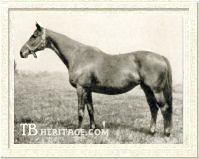
Mahubah
| |
MAHUBAH (1910) was and is Rock Sand's most celebrated daughter, although she was not the only one to contribute to his excellence as a broodmare sire. Out of the Merry Hampton daughter, imported Merry Token, and bred at Nursery Stud, she ran three times as a juvenile and twice at age three, winning a maiden race. Her importance derives from her famous son, Man o' War, the great chestnut racehorse and stallion, and to a lesser extent his brother, Jockey Club Gold Cup winner and useful sire, My Play, and their sister Masdah, a winner of six races and dam of three stakes winners. |
Another 1910 Rock Sand son was ROCK FLINT, out of Trigger, by Meddler. He was bred by Clarence Mackay, and sent to England as a yearling, where he was purchased by H.E. Beddington for 600 guineas. He was a promising juvenile winner of three races, worth £3,360, his wins included the July Stakes, Goodwood's Molecomb Stakes and Doncaster's Tattersall Sale Stakes. He did not train on well, and was retired to stud at Manderston Stud in Newmarket; one of his daughters, Sweet Rocket, produced a good winner in Bustle (by Eager). Rock Sand's son OCTOBER (1910, from the Hastings daughter, Octoroon), a stakes winner of three races in England, was sent to Australia, and got Melbourne Cup winner Bitalli.
Rock Sand's 1911 crop included October's sister, OKTIBBENA. She was unraced, but in Edward Simms' stud she produced three good runners: Sweepster (1924, by Sweep), who won 19 of his 32 starts, including the Remsem Handicap; Sweet Verbena (1926, by Negofol) winner of the CCA Oaks, and the long-running Okapi (1930, by Eternal), winner of 13 of his 72 starts, including the Toboggan Handicap twice.
In 1912 Rock Sand's foals included Danger Rock, who ran in England, and another good producer, Dona Roca.
|
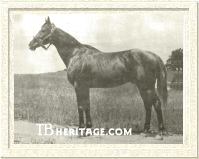
Danger Rock
| |
DANGER ROCK (1912) out of Delusion, by Meddler, was bred by Belmont and raced in England during the war. An elegant animal, he was cursed with Rock Sand's temperament. He won the 1-1/2 mile Hastings Plate and the Newmarket Stakes. During the running of the Zetland Plate, his off fore pastern was damaged, ending his career. Belmont sent him to the U.S., where he was placed in the Middleburg, Virginia, stud of Raymond Belmont. Danger Rock was not a particularly useful sire, but he did get the gelded stakes winner Doctor Wilson (1925), bred by John Madden, who collected $49,236 in earnings.
|
DONA ROCA (1912) was out of another Rayon d'Or daughter owned by Belmont, Donna de Oro. Dona Roca became the dam of two really good runners. In 1920, to the cover of Fair Play, she produced Dunlin, who won eleven of his 58 starts, including the Dwyer Stakes, and the Laurel, Potomac and Knickerbocker Handicaps. The next year she dropped Ordinance, one of the best of Ormondale's sons, purchased by Helen Hay Whitney when Belmont's stud was dispersed after his death. He just missed the three-year-old championship, having won five of his eight races at age three, including the Stuyvesant, Rainbow, Longbeach and Mount Vernon Handicaps.
Another good producing daughter of Rock Sand's born in 1912 was SPUN GLASS, from Hanover's daughter, Handspun. She bred the bay Broomspun in 1918 (by Broomstick), who won the Preakness Stakes; his leg was shattered by a kick soon thereafter and he was euthanized.
Rock Sand's 1913 crop included DAMROSCH (1913, from Hanover daughter Dissembler), who won the Preakness Stakes; U.S. champion FRIAR ROCK, and two particularly successful broodmare daughters, EPINE BLANCHE and CHIT CHAT.
French-born EPINE BLANCHE was out of White Thorn, by Nasturtium, who had been shipped to France by Belmont. Because of the war in Europe, Epine Blanche did not race, and went to stud in 1916, age three. She was barren twice, and produced a dead foal in her first several years in the stud, and in 1919 Belmont sold her to French perfume manufacturer Pierre Wertheimer. He sent Epine Blanche to Badajoz, a successful middle distance runner in France who won 15 races and whose fee was 5,000 francs. The resulting foal from this union was Epinard (1920), in-bred three times to the fast Springfield. Epinard was a brilliant runner, and Europe's darling, considered the best horse up to a mile at age three: he won Goodwood's Steward's Cup, carrying a record weight; Longchamp's Grand Criterium, the Prix de la Foret, and a number of other races that gave him the juvenile and three-year-old championships in France. He became a successful stallion in France, sire of Rodosto, Democratie, and other good runners.
CHIT CHAT (1913), out of Chinkara, a Galopin daughter that won as a juvenile in England, was not raced. In Belmont's stud she produced Chatterton (1919, by Fair Play), purchased by Frank Kelly, who, despite being a roarer, compiled a decent record of 15 wins in 32 starts over two years (ages 3 and 4), including the Autumn, Phoneix Hotel, Falls City, Louisville Hotel and Decoration Day Handicaps, his best distance was about 9 furlongs. Kelly died after Chatterton had stood two seasons at his stud, and Arthur Hancock purchased the horse for Claiborne Stud, where Chatterton got some good winners that unexpectedly rocketed him to the top of the sire's list in 1932, and to third place in 1934, the only times he made the top twenty. His best were the champion three-year-old of 1932, Faireno, who was also good at age five and led the handicap division; Current, and Chatford. CHIT CHAT also produced winners in Check and Chatterer, and a daughter, Etoile Filante, that became dam of Selima Stakes and Pimlico Futurity winner Fair Star and other good winners.
Another good-producing daughter of Rock Sand's born in 1913 was SAND POCKET (from Pocket Piece, by Hanover). She produced Prince of Wales (1923, by High Time), a winner of 23 races in 73 starts, including the Capitol Handicap at age three and again at age five, and the Pimlico Fall Serial WFA Race (No. 1).
|
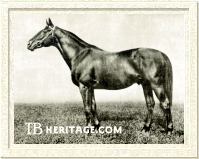
Friar Rock
| |
The black-spotted chestnut-coated FRIAR ROCK (1913) was out of the great broodmare imported Fairy Gold, by Bend Or. Purchased in England by Belmont for $18,000, Fairy Gold bred two foals there prior to Belmont's purchase -- St. Lucre, dam of Marcel Boussac's stakes winning mare Zariba, later a foundation mare for his French stud, and the good stayer Golden Measure. Her first foal in the U.S., for Belmont, was the Hastings son Fair Play (sire of Man o' War) and the next year, his sister, Golden View (dam of ROCK FLINT) was born. In 1911 she produced stakes winner Flittergold, and then Friar Rock; later she would produce Fair Gain (1917), a stakes winner by VULCAIN. |
FRIAR ROCK had excellent legs and feet, a sloping shoulder and powerful hindquarters. He won the Whirl Stakes and the Adirondack Stakes as a juvenile. He dominated both the three--year-old division and the handicap division the next year, in the latter beating the best of the older horses, including Roamer, The Finn, and Regret. His wins including the Belmont Stakes, the Brooklyn and Suburban Handicaps, gave him the title of champion horse of the year in 1916. After his win of the Saratoga Cup that year, Belmont sold Friar Rock to John Madden for a reported $50,000.
FRIAR ROCK was not a successful sire of runners, at least not directly, barely making the top twenty in the sire's list charts once in all his years at stud, but he did get the roarer Pilate (1928), winner of 24 races in 44 starts, and later sire of the excellent runner and sire Eight Thirty and of Belmont Stakes winner Phalanx. His other good winners included Rockminister (1919, six wins including the Latonia Championship Stakes and the Pimlico Cup Handicap), winner of $47,687 and sire of the tough steeplechaser and American Grand National winner Green Cheese; the gelded Flat Iron (1923, 21 wins in 107 starts, including the Hawthorne Handicap), winner of $71,347; Polydorus (1928, won Tremont Stakes and several handicaps), winner of $49,010; and Black Curl (1924), a winner of $25,870. In 1918 he was sold to California, standing at Rancho Wickiup in Santa Rosa, where he got some daughters that produced California stakes winners; he died in 1928.
FRIAR ROCK, like his sire, was better as a broodmare sire: he was five times in the top ten on the broodmare sire's charts, ranking as high as fourth twice. His daughter, Friar's Carse (1923), won several races, including Aqueduct's Fashion Stakes, and was later the dam of War Relic, War Kilt, Speed Boat and other good ones. Another daughter, Simpatica (1919) won two juvenile races and became the dam of the excellent three year old filly Suntica (1929), winner of the Kentucky Oaks, Illinois Oaks, and Latonia Oaks, and later dam of Gino Patty. Other daughters included Heloise (1925), winner of one race and dam of Tintagel and Dinner Date; Mission Bells (1919), dam of Blessings; Minima (1919), dam of the tough stakes winner Porter's Mite; Black Curl (1924, a daughter of Frizeur), who won 19 of her 30 races to age four, and was later dam of the solid stakes winner Black Wave (1935), herself later dam of the excellent juvenile and Kentucky Derby winner Jet Pilot (1944).
Rock Sand's last crop in the U.S., born in 1913, included the aforementioned TEA CADDY (from Tea's Over). Rock Sand's daughter, TOQUE, from TRACERY'S dam, Topiary, was born in France, where Topiary had been sent after she was confirmed in foal to Rock Sand in 1912 (Topiary made the trans-Atlantic trip yet again afterwards, and died in Kentucky in 1922). Toque was unraced, due to the war, and was bred to Negofol and shipped to England, where she dropped Torpille (1920). Her tail-female descendants included good stakes winners in England and France.
|
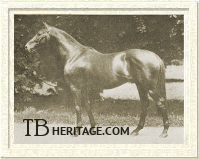
Sandy Hook
| |
Rock Sand's first French crop included SANDY HOOK (1914, from the good race filly Tangle, by Meddler), who raced in the disrupted years of World War I in France. He ran second to Brumelli in both the substitute Prix du Jockey Club and the Grand Prix de Paris, and later won the 2400 meter Prix de Croissy, but it's hard to assess his quality as a runner while the war was at its height and racing was essentially controlled by the German occupiers. He was later a useful sire in France whose winners included Sandcliff, a top Italian-raced colt, Zizonio, and Duc d'Anjou, winner of the Grand Steeple-Chase de Paris. |
Rock Sand's last group of youngsters, born in 1915, included GAVE (from Gazza Ladra, by Bay Ronald), who won the Prix Jean Prat twice; ROCKSAVAGE (from Manuka, by Eager), winner of five races and later a modest sire in England; and the unraced MINEFIELD (out of Fluke, by Speed), dam of Shanky, a winner of three races, and, after she was brought to the U.S., of Ladfield (1929, by Belmont's stallion Ladkin), who ran in 239 races over the course of his extended career, winning 47 of them.
NEEDLE ROCK (1915) was one of Rock Sand's last foals; she was out of Needlepoint, by Isinglass, and was bred by Colonel Charles Birkin, who had sent Needlepoint to France to be bred to Rock Sand. Needle Rock was unraced; Birkin bred her to the Aga Khan's stallion Diophon, and in 1927 she dropped Diolite, one of Diophon's first foals. Diolite was sold for the very small sum of 480 guineas at the Newmarket yearling sales in October, purchased by Fred Templeman for Sir Hugo Hirst. He was a narrow, lengthy stayer who grew to a little over 16 hands. He became the top juvenile in England, at the top of the Free Handicap, and at age three won the Two Thousand Guineas; in all he won six races to age five. He was later sold to Japan, where he was leading sire three times in the 1940s.
Rock Sand, if not one of the greats, was a very good racehorse. Well-supported by Belmont's band of homebred broodmares, and by Belmont's ability to ship in-foal mares back and forth across the Atlantic during the double-whammy of U.S. anti-betting legislation and the first World War, he got some excellent runners -- juveniles, middle distance horses, and stayers -- mostly colts, because of Belmont's aversion to running fillies either at all or very much. Some very good jumpers, both steeplechasers and show jumpers, descended from him both tail-male and through daughters. Through his son, Tracery, he had an enormous influence on South American breeding. He was an excellent sire of broodmares, and through their often extremely durable offspring he is woven into the classic U.S. pedigrees of twentieth century runners.
--Patricia Erigero
|
|
|
|

